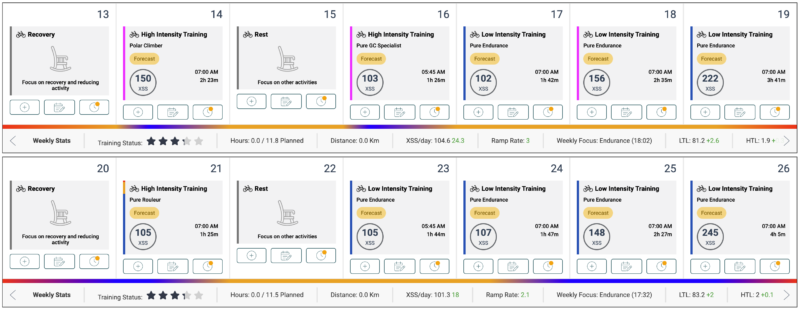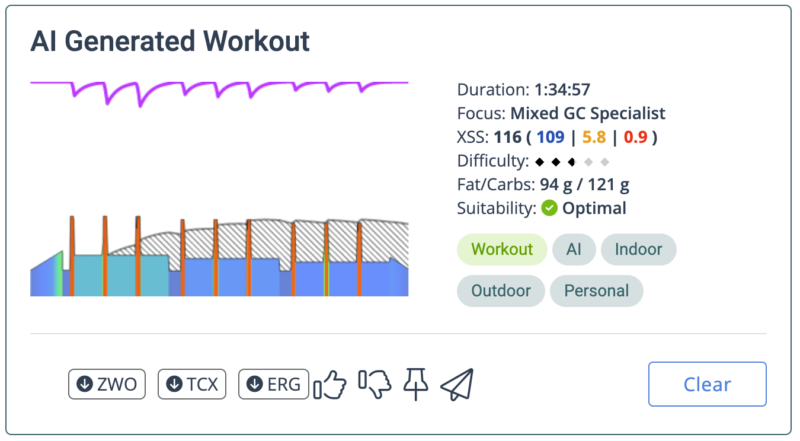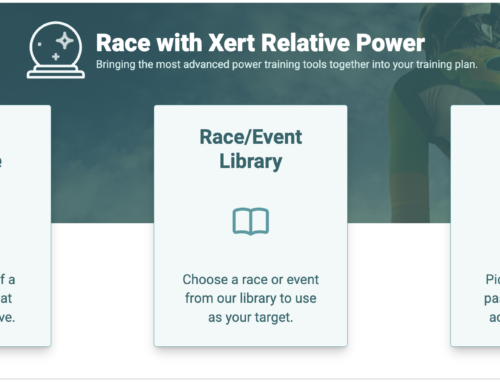Xert’s Forecast AI Looks Into the Future to Predict the Training You Will Need
In recent years, adaptive training has grown in prominence within training circles. Static training plans have become a thing of the past. Xert’s Adaptive Training Advisor was an early adaptive training platform, providing athletes day-to-day training advice that changed and adapted to each athlete over the course of their training. Almost a year ago, Xert announced the Forecast AI Beta Program. Forecast AI was a bold new initiative that raised the bar on how training could be prescribed. Before Forecast AI, athletes trained with the hopes of achieving the goals and outcomes they were looking for. With Xert’s Forecast AI, hopes have been upgraded to predictions. Outcome-driven training plans are now available for the first time.
In the past year, we’ve taken a lot of feedback from coaches and athletes and have made many improvements over this time. We’ve also added substantial new capabilities. At its core, Forecast AI (XFAI) generates training plans that are outcome-driven – goals, events, races, achievements – and have the following important features:
- Optimized and Outcome-Driven – XFAI generates a training plan using a sophisticated outcome-driven algorithm that takes you from where you are today towards the outcome you are looking for, and generates a plan to reach it.
- Personalized and Tailored to You – It uses a deep analysis of your training history and your preferences to create a training plan that’s unique to you.
- Highly Flexible – It fits the training program into your day-to-day availability but also enables you to do the prescribed training following structured workout or unstructured rides, both indoor and outdoor, solo or with others.
- Adaptable – Accommodates changes based on your availability or preference adjustments as well as adjustments needed to reach your desired outcome.
Next Level Personalized, Outcome-Driven Training Plans
We set out originally to simply take the Xert Adaptive Training Advisor and have it *forecast* the training you need to perform in the upcoming week. What would seem like a simple endeavour mushroomed into something far more complex but also far more capable and valuable to athletes. The team discovered many aspects of training that underlie successful training plans. It’s been an incredible learning experience and hopefully we’ve been successful in transferring what we’ve learned over to you and enabled you to reap the rewards of all of our efforts.
“AI” is being tossed around a lot these days since it’s such a hot topic. Some think of ChatGPT and Large Language Models as AI. But AI has been around a long time and doesn’t necessarily only mean having a chat with a computer that acts like a human. When computers are used to analyze lots of data and compute answers to hard problems, that too is AI. In creating Forecast AI, we tried many, many different computational methods used in the development of AI systems. We implemented, tested and tossed them out, learning more along the way about the problem space but also about the various methods we could employ. Sometimes the problem got harder because we needed more capability, or the solution became too complex, or it became too slow to be usable. After many attempts, we ended up finding some elegant solutions that were robust and highly-flexible, that generated training plans athletes can follow and benefit from in completely new ways. The method uses a 6 dimensional training load and recovery load space to map out functional progressive overload with multiple constraints and objectives. That’s technical jargon for “it was a very hard problem to solve”.
Fortunately, XFAI didn’t need to be an opaque AI black-box platform that works to provide a solution to a problem or generates an answer but there’s no understanding of the underlying method it used. XFAI isn’t such an AI system. XFAI simply does a lot of very complex calculations many, many thousands of times in finding a solution to a complex problem – generating a personalized, outcome-driven training plan. It presents a training plan that you can validate for yourself even. This should lend confidence that you will be on the right path, doing the right training towards the outcome you’re looking for.
Making it Personal
To say there is a “best” training plan that is suitable for everyone and we can use AI methods to find this training plan is a misunderstanding of how human physiology works. There is simply no “one size fits all” training plan. A good coach will go to great lengths to learn about their athlete. They need the specifics and the details in order to prescribe the training that is best suited to them. They recognize that everyone is different and the training that’s best for you may not be the training that’s best for another athlete. We believe to properly prescribe training requires a deep understanding of the athlete. It’s the most important step. Here’s how Xert characterizes each individual athlete:
- Every athlete has a unique fitness signature – Your TP, HIE and PP reflect your specific strengths and weaknesses as an athlete.
- Every athlete is at a unique point in their training – Low, High and Peak Training Loads and Recovery Loads are based on the training you’ve been doing and the unique mix of intensities that you have performed.
- Every athlete responds to training differently – Low, High and Peak Training Responsiveness reflect how you have responded to training in the past.
- Every athlete has a different pattern of training – The volume, durations, days-of-the-week you normally train form a baseline weekly training pattern.
- Every athlete has other differences and preferences:
- Recovery Demands – Do you prefer more or less recovery time between training sessions? Preference may be related to previous injuries or other personal factors.
- Polarization Level – Do you dislike doing long endurance workouts or prefer stricter 80/20 polarized training?
- Degree of difficulty – Can you handle a lot of suffering or prefer easier workouts?
- And most importantly, every athlete has a desired outcome for the investment they expect to make in following a training plan.
All these are elements that will make the training plan generated by XFAI unique to you and unlike any other program. A great coach will spend a lot of time working with you to establish all of these elements in order to craft a training plan that is right for you. XFAI does the same.
Making it Flexible
Flexibility in a training program is key because people like to do things in different ways. A training plan has to be something you not only can follow but you want to follow. A training plan that might meet an outcome objective is nice but if you don’t want to do the training, then it’s not a great plan. We sought to use your historical data as the starting point for the training since this is the pattern of training you already do. It’s also very important to use your historical data since the principle of progressive overload depends on this historical knowledge.
Here, you can adjust your availability for any day of the week or even adjust individual days. Mark the day as Flex to instruct XFAI to add time in order to achieve Progressive Overload. Mark the day as Fixed if that’s all the time you have that day throughout the plan.
An important change we made over the course of developing XFAI was the change from prescribing workouts, to prescribing workouts and outdoor rides, to eventually landing on forecasting the training you’ll need to do. You’ll notice that every training day is either “Low Intensity” or “High Intensity”.
Low intensity training days are days where you will ride easy and avoid high intensity. XFAI will put these in your plan either because your status is projected to be yellow (“Tired” status) that day or it plans to hold back on intensity because you don’t have enough time that day to do what’s needed and a subsequent day is better for doing the high intensity training.
High intensity training days are days where your training status is expected to be blue (“Fresh” status) and you will be expected to be rested enough to handle a high intensity workout or ride. XFAI will show you how much intensity is needed on that day and defines this so that you can continue to progress your high and peak training loads towards the target fitness levels needed.
Recovery days are days where your training status is red (“Very tired” status) and you should be taking downtime for recovery. Rest days are simply days that you don’t need to be training and can focus on other activities but will not affect your ability to achieve the target fitness by the target date.
How the Training Plan Gets Generated
XFAI generates a training plan and displays progress on screen. You can watch it as it works. For many of you that were part of the original beta, XFAI rolled forwards and backwards generating and laying out a plan, rethinking decisions along the way. It took a long time to run. Since then, we found ways to improve the performance and improve how it lays out the training plan. What makes this really unique and valuable is that you can see the end result and understand how and why it made the decisions in the process of laying out the plan. Once this process is complete, you’ll see a plan that will make sense to you and you can even confirm for yourself that it’s indeed a plan that will achieve the outcome you requested.
Unlike other AI systems that may generate a training plan but won’t show their work, XFAI lays everything out for you, letting you see and appreciate how the outcome will be reached. This helps you have confidence in the program which in turn will provide greater motivation for you to follow and stick with it. You don’t have to place trust in the system. It’s all laid out and understandable.
Executing the Training Plan and Updating it Along the Way
We took flexibility and personalization one step further and made these a part of the process of following and updating the training plan as you execute the training. Next, next, next level stuff. Here’s what you can do on a day-to-day basis:
Once all this is done, click the Adapt button to take all this new information and XFAI will update and re-optimize the training plan for you:
How much flexibility can be accommodated?
One thing we learned in the process of developing Forecast AI is that the flexibility you have in a training plan is dependent on how tight you will be to reach the target fitness by the target date. A plan loses its flexibility when you miss too many days, for example, and a suitable training plan can no longer be forecasted. Simple example: if you have a week left in your plan and had targeted to reach a TP of 250 but it’s still at 230 because of all the training you’ve missed, no training plan exists that you can follow to reach your target. A plan can be flexible .. but at some point the flexibility goes away and if you miss the required training, the target outcome can’t be reached.
Forecast AI helps you see this happening when it highlights “magenta” days on your planner and chart. When a plan is created, future training days depend on you achieving a certain fitness level by that date. For example, as you build your fitness, your High Training Load may start very low, perhaps quite low after a period of Base training but as you progress in the training plan, High Training Load increases towards your target fitness. This in turn requires more High XSS to maintain the controlled, achievable progressive overload towards the target. If at some point XFAI expects your High Training Load (or Low or Peak) to be a certain value in order for you to complete the required training and your projected training load will be less such that you can’t complete the training on that day, it’ll be marked as magenta. Similarly, if XFAI had mapped out a high intensity day but due to the increases that are projected in high/peak training loads and recovery loads on that day, your status may be projected to go from blue to yellow or red. Again, these days will be marked as magenta on the plan, highlighting that the plan has an issue that may need to be addressed. Often, it may just be a matter of clicking the Adapt button. But if the plan has become super tight, the Adapt button might not succeed in finding a plan and you’ll need to consider either changing availability or perhaps modifying your targets.
Mouse over the magenta bar to see how the training has been affected.
Checking Progress
We’ve added a new page that provides feedback on the progress you have achieved as well as the progress you will make in the training plan. This provides a complete picture of changes to your fitness signature both past and future as well as the corresponding training loads. Use the slider to navigate through the past and future dates.
Conclusion
Xert’s Forecast AI has set a new high-bar when it comes to planning your training. Ultimately, the plan you will follow:
- Has you reaching the fitness and performance you are looking for.
- Is highly-personalized to you, your specific situation and your unique interests in training.
- Allows you the greatest flexibility to train in ways you prefer. This is motivating and encourages you to stick to the training.
- Continuously adapts to your changing schedule and the progress you have made, ensuring you can stay on track as life gets in the way.





















